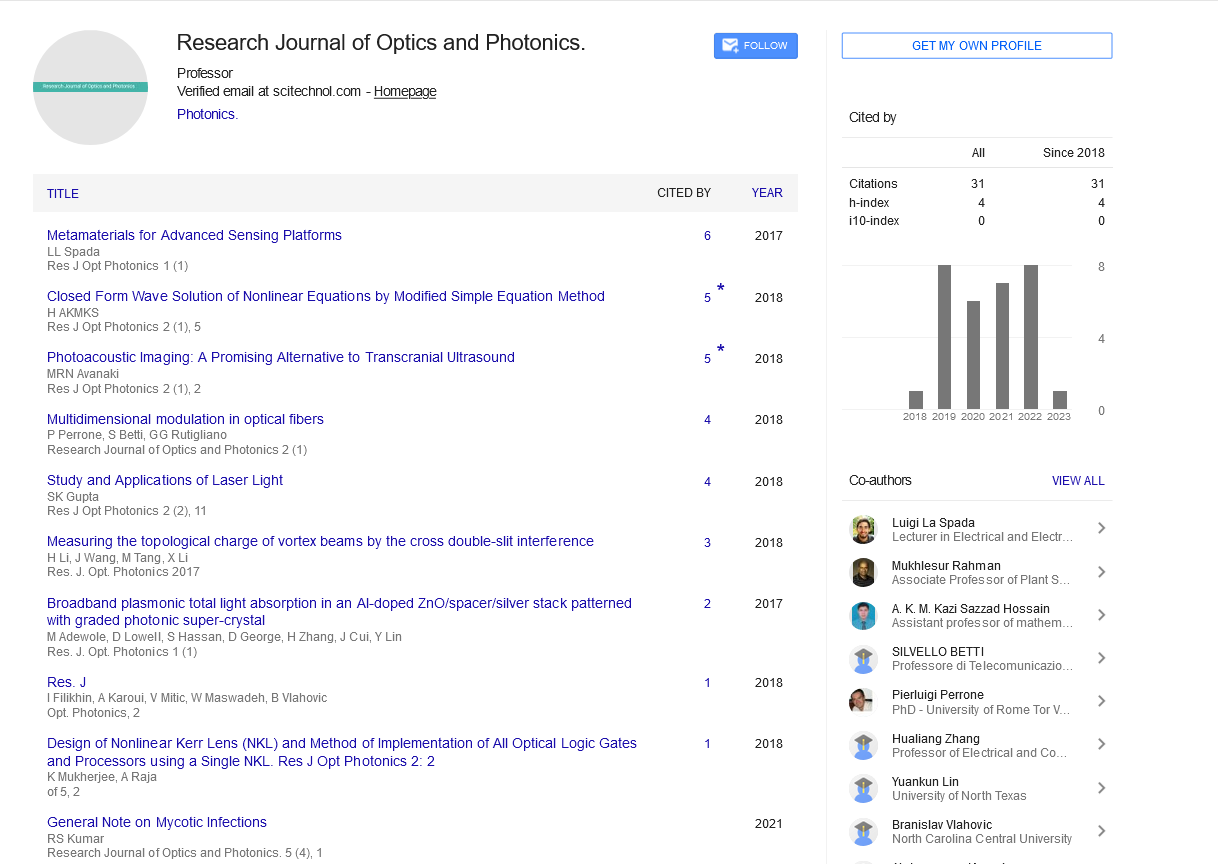Editorial, Res J Opt Photonics Vol: 4 Issue: 3
Glance at Photonic Integration
Felix Jaetae Seo*Department of Physics, Hampton University, Hampton, Virginia, USA
*Corresponding Author : Felix Jaetae Seo
Department of Physics, Hampton
University, Hampton, Virginia, USA
Tel: 757.727.5149
E-mail: jaetae.seo@hamptonu.edu
Abstract
Integrated Photonics is use of light for the applications traditionally addressed through electronics, it finds use in wide range of area including: sensing, telecommunications, data communications, laserbased radar, and so many. It is specLficaOO\ silicon photonics, dramatically improves on performance and reliability of electronic integrated circuits while sLJnLficantO\ reducing size, weight, and power consumption
Keywords: Photonics
Editorial
Integrated Photonics is use of light for the applications traditionally addressed through electronics, it finds use in wide range of area including: sensing, telecommunications, data communications, laserbased radar, and so many. It is specifically silicon photonics, dramatically improves on performance and reliability of electronic integrated circuits while significantly reducing size, weight, and power consumption.
Developing widely accepted set processes and protocols for design, manufacture, and integration of photonics systems will not only advance this technology in US, but also present a tremendous economic opportunity, with overall global market estimated to the grow to in excess of $798 billion by 2022. It will enable advancement of aforementioned applications, as well as others, in 21st century in same manner that semiconductor microchips fostered the revolution in computing over past 40 years.
Chip-scale integration has dramatically increased performance, reflected in Moore ’ s law, of electronic devices such as personal computers, cell phones, MP3 players, and other devices, with no significant increase in prices. In first decade of second millennium, the question is whether time has come for photonic integration, with hybrid electronic and photonic integration, which exert same force. This question is certainly being asked by federal advisory panels, by various industries, by professional societies. Their interest is motivated by emergence of silicon photonics and advances in nonlinear optical materials. Less well recognized by general public, but just as important, is effect of electronic integration on transportation, medicine, business, and defense. Many other ways, technology has proven to be most influential of 20th century.
Integrated Photonics is becoming increasingly well recognized by combining photonic components can provide size, weight, and power (SWAP) reductions together with better performance for example, in speed and bandwidth, and reliability analogous to electronic integration. The photonic systems do not lend themselves to monolithic consolidation. But silicon affords many desirable photonic properties at telecommunication wavelengths. Exceptional SWAP reductions and performance enhancements have recently been realized combining III-V semiconductors and organic nonlinear optical materials with silicon photonic circuitry. Such hybrid integration, while losing some of cost advantages of single foundry manufacture, suggests chance of revolutionary new technology.
Photonics starts with photons, or particles of light. According to insights of quantum physics, light can act as both wave and particle paradigm first proposed by Albert Einstein in 1905. Photonics is science of creating, moving, and detecting photons. It brings together physics, electrical engineering, and materials science knowledge about photons and electrons. Photonics technology surrounds us in the modern world: CT scans, barcodes, LED lights, flat screen TVS, cellular phone networks, CD and DVD players laser-guided missiles, fiber optic communications, solar power, driverless cars. Light-based technologies are efficient, reliable, and fast.
 Spanish
Spanish  Chinese
Chinese  Russian
Russian  German
German  French
French  Japanese
Japanese  Portuguese
Portuguese  Hindi
Hindi 